Archive for the ‘Genealogy & DNA’ Category
Friday, November 6th, 2009
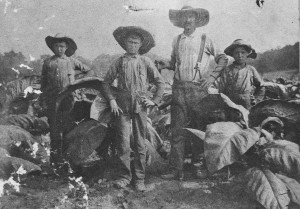
White Sharecroppers on Wessyngton Plantation
After the Civil War several former Wessyngton slaves remained on the plantation. Others moved to Nashville, to the north, surrounding counties and some purchased their own farms.
When the former slaves left the area many white farmers and African Americans came to Wessyngton Plantation and became sharecroppers and resided in the former slave cabins.
Under the sharecropping system, the landowner received two thirds of the crop and the tenant or sharecropper only received one third of the crop. The sharecropper was provided a house, mules, land, seed and fetilizer. They raised crops of tobacco, corn, wheat and rye.
African American and white sharecroppers continued farming on Wessyngton Plantation until the property was sold by the Washington family in 1983 nearly 200 years after the plantation was founded.
Tags:Add new tag, Plantation, Sharecrop, Sharecropping, Slave cabins, Slave Housing, Tenant Farmers, Tenant Housing, Tobacco Production
Posted in Civil War, Genealogy & DNA, Interviews, Plantation Life, Research | Comments Closed
Monday, November 2nd, 2009
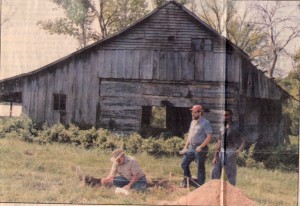
Archaeological Dig at Wessyngton Slave Cabin Site
In 1991, I had an opportunity that few historians or genealogists ever have; to literally walk in your ancestors’ footsteps. In 1989 I was approached by the president of the Bloomington-Normal black history Project and director of the Midwestern archaeological research Center, about the potential investigations of the salve cabin area on Wessyngton Plantation to get an interpretation of slave life there. Similar digs have been conducted at the Hermitage, Mt. Vernon, and Monticello.
The actual digging at Wessyngton did not start until 1991. The thought of actually walking in my ancestors’ footsteps and holding objects they used in their everyday lives one hundred years earlier was surreal to me. Three sections of the slave cabin area were selected for exploration. One site was where the cabin of my great-great-grandparents Emanuel and Henny Washington once stood.
The dig yielded fragments of pottery and dishes used by my ancestors as well as coins and arrowheads made by Native Americans.
The photograph above shows the site of the archaeological dig on Wessyngton Plantation where my ancestors once lived.
Tags:African American History, African Slavery, Arrowheads, black history, Black History Month, Civil War, Monticello, Mt. Vernon, Native Americans, Plantation Archaeology, plantation slavery, Slave Cabin, Slave Housing, Slave Life, Tennessee slavery, The Hermitage
Posted in Civil War, Genealogy & DNA, Interviews, Introduction & Personal, Plantation Life, Research | Comments Closed
Monday, October 26th, 2009
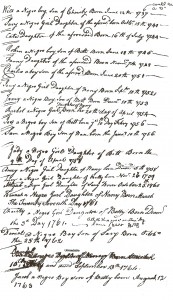
Blow Family Bible
Slave owners kept detailed records of their slaves’ births, and deaths, and purchases; although many of them have not survived. They often recorded these events in their family bibles along with information on their own families.
The 1715 Blow family bible records the births of slaves owned by the Blows of Sussex, and Southampton counties in Virginia. Nineteen births of four mothers are recorded from 1737 to 1763 spanning three generations. This is a goldmine of information for African American research. Descendants of these slaves can be found searching other records in the Blow Family Papers in the Swem Library in Virginia.
Tags:African American History, African American Names, African Slaves, Black Genealogy, Blow Family, Blow Family Bible, family history, family research, Genealogy & DNA, George Blow, Michael Blow, plantation slavery, Richard Blow, Samuel Blow, Slave Bill of Sale, Slave Name Patterns, Slave Names, Slave Records, slave trade, Southampton County Virginia, Sussex County Virginia, Swem Library, Tower Hill Plantation, Transatlantic Slave Trade, Virginia Plantation, Virginia Slavery
Posted in Civil War, Genealogy & DNA, Interviews, Introduction & Personal, Plantation Life, Research | Comments Closed
Friday, October 23rd, 2009
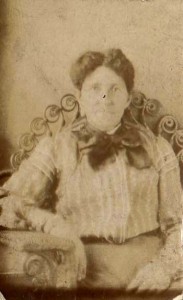
Arry Fort Pitt 1836-1918
Today divorce is very common, but in 1800s and early 1900s it was rarely heard of, especially among African Americans. In my research I found this extraordinary divorce case of two former slaves in Robertson County, Tennessee which detailed the history of their family.
Alford Pitt 1830-1900 and his wife Arry Fort Pitt 1836-1918 were married during slavery and had eleven children. Alford was a carpenter and later accumulated more than 500 acres of land. He had African American and white sharecroppers working his land.
In 1900, Arry filed for divorce from Alford stating that he had an affair with two black women and one white one. She stated that she had worked hard to help him amass everything they owned and she was entitled to half. Alford claimed that she had not helped him accumulate his wealth and felt since they married during slavery and never married after they were emancipated that she was not legally his wife and therefore not entitled to any of his property.
The divorce case put a great strain on the Pitt family, their friends and neighbors. Arry had more than fifty witnesses to prove her claims and Alford had nearly as many to support his. Half the children sided with their mother and the others their father.
Arry was represented in court by a family member of her former owners. In 1866, a law was passed in Tennessee which made all former slave marriages legal if the couple continued to live as man and wife.
The courts ordered Alford to give Arry 100 acres of land, $1,000, a horse and buggy and other livestock. Shortly after the verdict Alford died from complications of a cold that he caught from walking to court in bad weather.
Some of the Pitt property is still owned by their direct descendants. A street that runs through the property bears the family name.
Tags:African American Genealogy, African American History, Black Landowners, Divorce, Divorce Cases, Emancipation, family history, family research, Freedmen, Freedmens Bank, Freedmens Bureau, Genealogy & DNA, Oral History, Pitt Family, Slave Family, Slave Marriage, Slavery
Posted in Genealogy & DNA, Interviews, Introduction & Personal, Plantation Life, Research | Comments Closed
Tuesday, October 20th, 2009
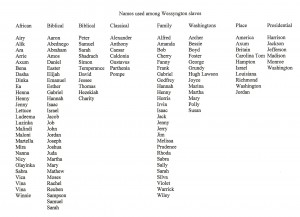
Names Among Wessyngton Slaves
African Americans got their given or first names from various sources during the slavery. Some of them used African “day names” such as Cudjo, Mingo, and Cuffee, denoting the day of the week on which they were born. Others used names from the Bible, classical names, place names, names of plantation owner’s families, famous individuals like the presidents and their own family members.
The document above lists various sources of names of individuals enslaved on Wessyngton Plantation from 1796 to 1865.
Tags:African American History, African American Names, African American slavery, African Names, Biblical Names, Day Names, Naming Practices, Slave Names
Posted in Civil War, Genealogy & DNA, Interviews, Plantation Life, Research | Comments Closed
Saturday, October 17th, 2009
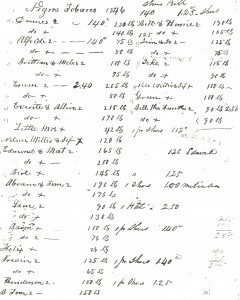
Slaves' Tobacco on Wessyngton Plantation 1846
Enslaved African Americans on Wessyngton Plantation worked under a task system. The plantation owner assigned a task to each individual. Once the task was completed the slave was free to work on his own crops of tobacco if he chose to do so. The owner usually assigned tasks that would take the entire day to complete. However, some of the fastest workers were able to complete the assigned tasks and work for themselves. The slaves were not required to work on Sunday and were off half days on Saturdays. Many of the slaves used this time to cultivate their own crops. The task system required less supervision by overseers than gang labor and gave slaves more control of their time.
The owner kept a list of how much tobacco each person raised and paid them after the crops were sold in New Orleans. The slaves used the money from the sale of the crops to purchase various items not provided by the plantation owner. The document above lists the names of men on Wessyngton Plantation in 1846 who raised their own crops and the items they purchased for their families.
Tags:Add new tag, Field Hands, Gang Labor, Overseer, Plantation Owner, Plantation Production, plantation slavery, Plantation Slaves, runaway slaves, Slave Life, Southern Plantations, Task System, Tobacco Production, Work Songs
Posted in Civil War, Genealogy & DNA, Interviews, Introduction & Personal, Plantation Life, Research | Comments Closed
Monday, October 12th, 2009
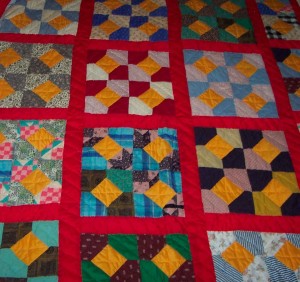
Hand-Stitched Quilt by Maggie Washington
So many of us have quilts or other crafts made by our ancestors. Hopefully we all display them carefully in our homes. But these pieces have stories that need to be preserved as well. This quilt was sewn by my great-aunt Maggie Washington. She made it for me as a birthday gift when she was in her nineties. Aunt Mag learned to make quilts from her mother when she was a small girl and often gave these special gifts to family members and friends on specials occasions such birthdays, weddings and Christmas.
Tags:Arts, Crafts, Maggie Washington, Quilt making, Quilting, Quilts, Sewing, Weaving
Posted in Genealogy & DNA, Interviews, Introduction & Personal, Research | Comments Closed
Sunday, October 11th, 2009
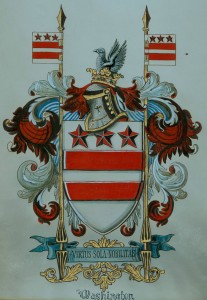
Washington Family Crest
The Washingtons trace their ancestry back to William de Hertburn in twelfth-century England where their family owned a manor estate called Wessyngton─the Norman spelling of Washington. William de Hertburn changed his name to William de Wessyngton. The first Washington to come to America in Joseph Washington’s line was John Washington, who immigrated to Surry County, Virginia, in 1658. One of John’s cousins also named John immigrated to Westmoreland County, Virginia, in 1656. This John Washington was the great-grandfather of President George Washington. Joseph Washington came to Robertson County, Tennessee in 1796 and established Wessyngton Plantation, which he named in honor of his ancestral home.
Tags:Ancestral Home, Ancestry, President George Washington, Sulgrave Manor, Surry Washingtons, Washington family, Washington genealogy, Wessyngton Manor, Westmoreland Washingtons, William de Hertburn, William de Wessyngton
Posted in Civil War, Genealogy & DNA, Interviews, Introduction & Personal, Plantation Life, Research, Uncategorized | Comments Closed
Wednesday, October 7th, 2009
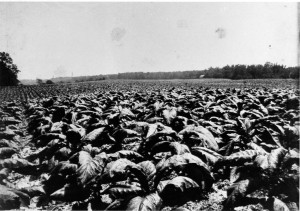
Wessyngton Tobacco Field
Slaves toiled endlessly, clearing land, plowing fields, raising livestock, erecting buildings, and planting crops to transform frontier landscapes into lavish plantations.
The enslaved population on Wessyngton Plantation primarily produced tobacco, which was very labor intensive. In 1860, 250,000 pounds of tobacco was produced on Wessyngton making it the largest producer of tobacco in the United States and the second largest in the world.
Tags:African American Plantation Life, African American slavery, black history, Civil War, plantation slavery, Plantation Slaves, Slave Labor, Slave Life, Slavery in America, Tennessee slavery, tobacco plantation, Tobacco Production
Posted in Civil War, Genealogy & DNA, Uncategorized | Comments Closed
Monday, October 5th, 2009
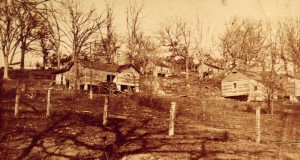
Wessyngton Slave Cabins
Housing for slaves varied from plantation to plantation depending on the owners. Most slave quarters were generally arranged in avenues or streets and located behind the mansion or ‘Big House.’ They were strategically placed to give the owner or overseer a clear view of the slaves, so their activities could be easily monitored.
The slave settlement at Wessyngton Plantation, however, did not fit this pattern. The lack of a clustered settlement pattern at Wessyngton was somewhat unusual during antebellum times. This was primarily due to the hilly topography of the plantation. The scattered pattern gave the slaves at Wessyngton more freedom and made it far more difficult to keep them under constant surveillance.
Typically, slave housing at Wessyngton consisted of hand-hewn one-room log cabins measuring 20 by 20 square feet with brick end chimneys. Some cabins were 18 by 36 square feet. Each cabin had log flooring and a loft, where children slept.
Each cabin housed an average of six individuals. Family sizes varied depending on the number births, deaths and marriages.
Tags:African American Family Life in Slavery, African Slavery, Antebellum Mansion, Antebellum Plantation, Big House, Civil War, Great House, Log Cabin, Log Housing, Overseer, Slave cabins, Slave Family, Slave Houses, Slave Housing, Slave Plantation
Posted in Civil War, Genealogy & DNA, Interviews, Introduction & Personal, Plantation Life, Research | Comments Closed









